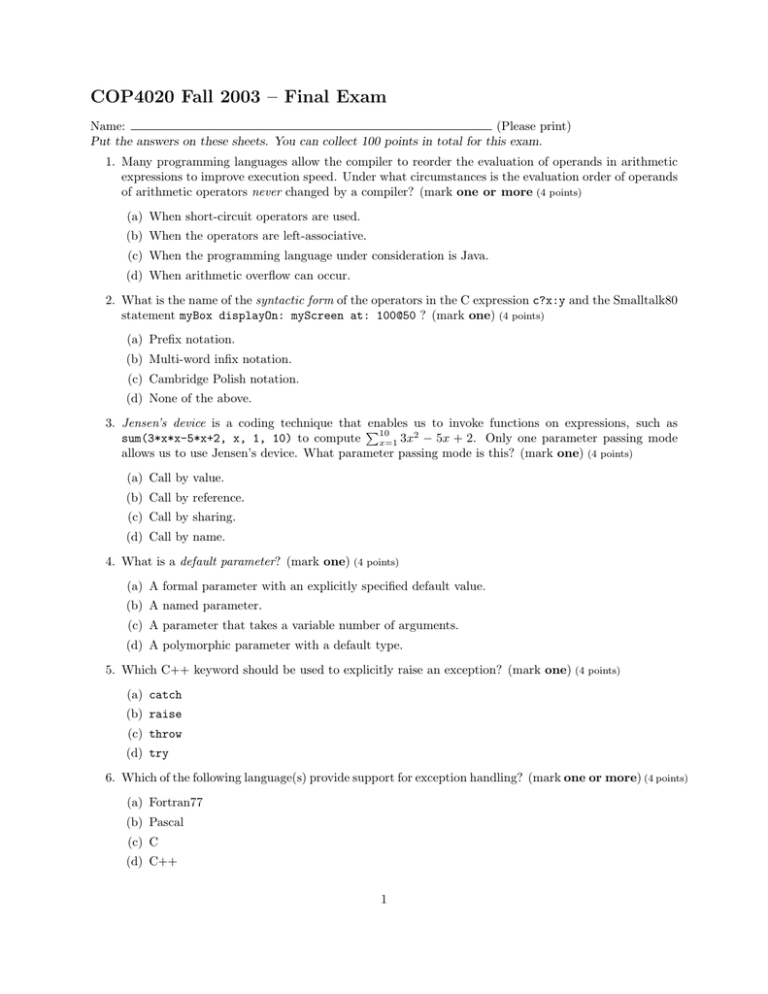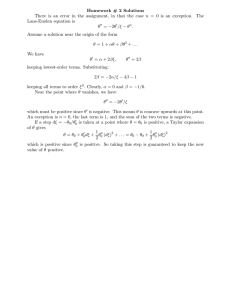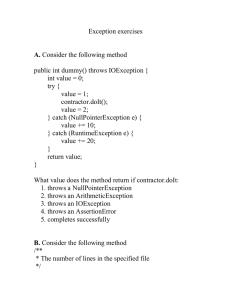COP4020 Fall 2003 – Final Exam
advertisement

COP4020 Fall 2003 – Final Exam
Name:
(Please print)
Put the answers on these sheets. You can collect 100 points in total for this exam.
1. Many programming languages allow the compiler to reorder the evaluation of operands in arithmetic
expressions to improve execution speed. Under what circumstances is the evaluation order of operands
of arithmetic operators never changed by a compiler? (mark one or more (4 points)
(a) When short-circuit operators are used.
(b) When the operators are left-associative.
(c) When the programming language under consideration is Java.
(d) When arithmetic overflow can occur.
2. What is the name of the syntactic form of the operators in the C expression c?x:y and the Smalltalk80
statement myBox displayOn: myScreen at: 100@50 ? (mark one) (4 points)
(a) Prefix notation.
(b) Multi-word infix notation.
(c) Cambridge Polish notation.
(d) None of the above.
3. Jensen’s device is a coding technique that P
enables us to invoke functions on expressions, such as
10
sum(3*x*x-5*x+2, x, 1, 10) to compute x=1 3x2 − 5x + 2. Only one parameter passing mode
allows us to use Jensen’s device. What parameter passing mode is this? (mark one) (4 points)
(a) Call by value.
(b) Call by reference.
(c) Call by sharing.
(d) Call by name.
4. What is a default parameter? (mark one) (4 points)
(a) A formal parameter with an explicitly specified default value.
(b) A named parameter.
(c) A parameter that takes a variable number of arguments.
(d) A polymorphic parameter with a default type.
5. Which C++ keyword should be used to explicitly raise an exception? (mark one) (4 points)
(a) catch
(b) raise
(c) throw
(d) try
6. Which of the following language(s) provide support for exception handling? (mark one or more) (4 points)
(a) Fortran77
(b) Pascal
(c) C
(d) C++
1
7. Which of the following pairs of terms in Prolog unify? (mark one or more) (4 points)
(a) 1 = 2
(b) 1 = a
(c) 1 = X
(d) one(two,Three) = one(Three, two) (Hint: look carefully at this one!)
8. Consider the following Prolog program:
stone(ruby).
stone(diamond).
valuable(gold).
valuable(silver).
valuable(ruby).
valuable(diamond).
precious_stone(X) :- valuable(X), stone(X).
What is the first answer for the value of Y in to the following query? (mark one or more) (4 points)
?- precious_stone(Y).
(a) Y = gold
(b) Y = silver
(c) Y = ruby
(d) Y = diamond
9. Apply tail recursion optimization to the following function by removing the recursive call and replacing
it with a loop to compute the same result. (7 points)
int log2(int n, int m)
{ if (n < 2)
return m;
else
return log2(n/2, m+1);
}
Note: log2(n,0) computes the integer base-2 log of a positive value n.
2
10. List the seven major categories of control flow ordering constructs.
(7 points)
.
11. Ada adopts call by value and call by reference parameter passing for in-mode parameters. Explain
under what circumstances an Ada compiler may consider call by reference instead of call by value
passing. (Hint: what is the property of the object passed that influences the decision at compile time?)
(7 points)
12. Consider the following program:
var x : integer; /* global variable */
procedure series(y)
begin
x := x + 1;
y := y + x;
end
begin /* body of main program */
x := 1;
series(x);
write_integer(x)
end
For each of the parameter passing modes shown in the table below show the value printed by the
program. (8 points)
By value By reference By value/result
Output:
3
13. Give an example of a logically controlled pre-test loop and a post-test loop.
(7 points)
14. Given that A and B are true, show that D is true by applying forward chaining on the rules:
C :- A.
D :- B, C.
Show the steps in the resolution process.
15. What is a catch-all exception handler?
(7 points)
(7 points)
4
16. Consider the following Java code:
class
class
class
{
(1)
(2)
(3)
(4)
[A]
(5)
(6)
(7)
(8)
[B]
(9)
[C]
(10)
ValueOutOfRange extends Exception { }
NegativeValue extends ValueOutOfRange { }
TestMyExceptions
private DataInputStream stream;
private void check(int value) throws ValueOutOfRange
{
if (value < 0)
throw new NegativeValue();
if (value > 100)
throw new ValueOutOfRange();
}
private int getValue() throws __________________________
{
int value;
try
{
value = Integer.parseInt(stream.readLine()); // may throw IOException
check(value);
}
catch (NegateValue e)
{
value = 0; // when negative, make it zero
}
return value;
}
public TestMyExceptions() throws __________________________
{
int sum = 0;
try
{
stream = new DataInputStream(System.in);
for (;;)
sum += getValue();
}
catch (IOException e)
{ System.out.println("Sum is " + sum);
}
catch (ValueOutOfRange e)
{ System.out.println("Value out of range");
}
}
}
(a) List the exception(s) (IOException, ValueOutOfRange, and/or NegativeValue) that can be
raised by methods getValue and TestMyExceptions at the throws points indicated. (6 points)
(b) Suppose a negative integer value was parsed at point (3) in the program. Which exception handlers
[A], [B], and/or [C] are invoked and which statements (1)–(10) will be executed after raising the
exception and before continuing with the loop (8)? (6 points)
(c) Suppose an integer value larger than 100 was parsed at point (3) in the program. Which exception
handlers [A], [B], and/or [C] are invoked and which statements (1)–(10) will be executed after
raising the exception? (6 points)
5





